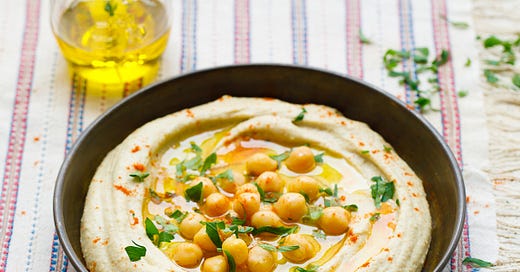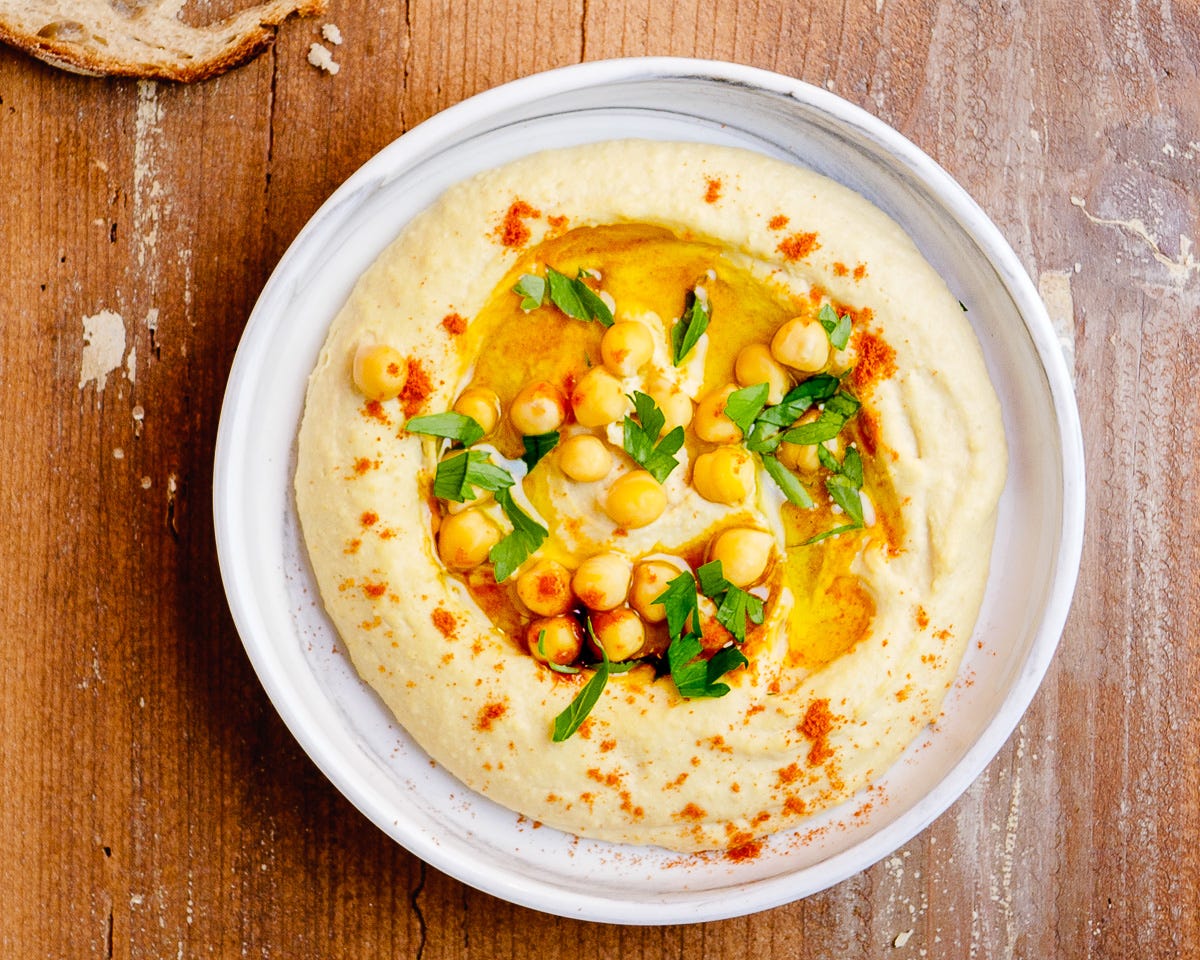In Behind the dish, I take an in-depth look at the background or making of a traditional dish.
What constitutes a perfect hummus varies wildly from place to place, and from person to person.
At an early point in my relationship with this most famous of Middle Eastern delights, I was convinced that it had to be super smooth, fluffy and creamy. Anything else was a Western abomination. As I moved from London to Istanbul, and from finance to food writing, it wasn’t long before I was humbled. Turns out the idea of smooth and creamy hummus is a fairly Israeli-centric perspective.
I’ve since been served hummus that is dense, almost coarse, rather than smooth – and more sharply lemon-y and raw garlic-y than creamy – from people who have literally grown up with it. This is how many people make their hummus in the lands where the dish likely originated, near where the first chickpea crops were planted more than 10,000 years ago. Others, of course, prefer it smoother and creamier.
This, of course, is as it should be. Hummus is literally the Arabic word for chickpeas. The early versions were essentially cooked and crushed chickpeas. Tahini, essential to current day hummus, came into the game much later. Technically, the dish most of us refer to as hummus is actually hummus bi tehina. “Chickpeas with tahini”.
Having tasted countless versions in different countries (and tried many more variations at home), I still prefer my hummus smooth and creamy, with more of a hint than an overload of lemon and garlic. There are many ways of achieving this, but these are six rules I swear by. Regardless of your personal preferences, they should be useful if you’re looking for ways to up your hummus game.
And if you have other or additional perspectives, please do share in the comments!
1 Start with dried chickpeas
No ifs, no buts: If you want the very best hummus, you’ve got to start with dried chickpeas.
Sure, you can make a passable version with the canned variety. Decent, even. But whether you like your hummus chunky or smooth, creamy or sharp in flavour, swap the canned for dried and your hummus will get an instant upgrade.

There are many reasons for using dried chickpeas rather than canned.
Flavour is one. Tinned chickpeas will always have a lingering taste of the liquid it’s been sitting in.
Texture is another. Tinned chickpeas vary wildly in in how well cooked they are. Most simply aren’t soft enough to achieve a smooth texture. Some people counteract this in way I’ll never understand, for example by boiling them some more or skinning(!) the chickpeas one by one. If you’re going to boil them anyway, starting with dried is virtually no extra effort – and why anyone thinks peeling individual chickpeas is a good use of anyone’s time is forever beyond me.
2 Bicarbonate to soften the chickpeas
In ancient times, most cooking was done in clay pots. This would have made for excellent legume based foods. I’m not sure if the Romans and others knew this at the time, but clay turns the cooking liquid slightly alkaline. Alkaline liquids, in turn, help break down the skin of legumes more quickly.
Most of us don’t cook in clay pots these days, but we can still make use of the effect that made them such good vessels for cooking legumes. By adding a good pinch of bicarbonate of soda (baking soda) to the cooking water, you’ll turn it more alkaline. This can dramatically reduce the time it takes for the chickpeas to cook – sometimes to as little as 20 minutes (assuming you’ve already soaked them).
In fact, it’s so effective I never add it when boiling chickpeas for salads or stews. The time it takes for them to go from perfectly cooked to mushy is simply too short with bicarbonate in the mix. For super smooth hummus, however, I find slightly mushy chickpeas are the ideal starting point. With the help of bicarbonate, it’s an easy job to get the chickpeas to this point.
3 Keep the cooking water
There are (at least) two schools when it comes to turning your hummus light and fluffy rather than dense. One uses the chickpea cooking water, which is full of starches. Another one prefers ice water, which is another way of trapping air in the mixture.
I prefer the former, for two reasons: One, there’s still a lot of flavour in the cooking water. Two, it’s easier. The cooking water’s already there.
So: Don’t throw the chickpea water down the drain, but keep it for your hummus. And if you accidentally do drain the whole thing away, don’t worry too much. Just substitute really, really cold water (put a few ice cubes in it).
4 Make the hummus while the chickpeas are still warm
Warm chickpeas blend into a fluffier mixture than cold ones do. They don’t need to be boiling hot, but they should be quite a bit warmer than room temperature – and most certainly not chilled.
If life gets in the way and your chickpeas and its cooking water get cold, just reheat the pot before proceeding to make hummus.
5 Use a great tahini – and lots of it
This is where a lot of Western recipes fail. To make great hummus, you need a great tahini. And you need lots of it. In fact, as its full and proper name “hummus bi tahina” suggests, tahini is nearly as important to hummus as chickpeas are.
Besides adding a ton of flavour, tahini is essential for texture. It makes the end result more pleasantly fluffy and creamy, while also keeping the hummus from becoming dry. Make sure to leave the blender or kitchen machine running for a while for maximum creaminess – it can take a few minutes to reach optimal fluffiness.
There are huge quality differences between the various makers of tahini. Availability will vary according to where you live, but as a rule of thumb, Arab brands are a safe bet. Western brands (including, sadly, Turkish, Greek and Cypriot ones) are generally quite bad. As always, there are exceptions both ways, so do try out a variety of brands that are available in your community until you find one you really like.

Good tahini has a pleasant taste and doesn’t feel claggy in your mouth when tasting it straight from the jar. Lesser quality ones, on the other hand, often have a bitter aftertaste and feel like they get stuck all over your mouth.
Regardless of quality, tahini will separate over time as the oils rise to the top and the solids fall to the bottom. It’s important to stir the tahini vigorously before every use, making sure it’s completely homogenous before adding to whatever dish you’re making. I usually use a fork for this purpose.
6 Olive oil? Only to garnish
This is more of a word of warning than a tip, but I wanted to address the many (mostly Western) recipes that call for olive oil in the hummus mixture. This is usually because they’ve used too little tahini, making the hummus dry. To counteract this, they add olive oil.
Unfortunately, in hummus, olive oil is inferior to tahini in every way. It’s not a great match flavour-wise, and it usually makes the texture worse rather than better. It may even make your hummus feel greasy. Use enough tahini, however, and there’s no absolutely need for adding olive oil in the mixture.
Olive oil is brilliant, though, drizzled on top as a garnish, where the flavours of the hummus and the olive oil can mingle in a different way. Don’t be afraid of topping your hummus with a generous amount of olive oil – but make sure it’s a good quality extra virgin one. I prefer a mild flavoured variety.
Bonus tip
Want to have hummus virtually at the ready? Boil a big batch of chickpeas and freeze in suitably sized portions with their cooking water. Then all you need to do is thaw them, warm them up and run the blender with the other ingredients. As quick as using canned chickpeas, but with all the flavour and texture of home cooked ones.
With all that in mind, it’s time to make hummus! Click the button below to get the recipe I use for making silky smooth and creamy hummus:
🔜 Decide on Friday’s new recipe
In the next newsletter, I’ll share a recipe for a delicious variation of hummus with a meat topping. But which one of these would you like to get? Vote below in the next 24 hours. The winning recipe will hit your inbox on Friday.
(Photo of Hummus with spiced lamb & pomegranate by Mette Randem.)











You might have just convinced me to actually buy a jar of tahini with the freezer portion trick... I usually buy in my hummus because whilst I love hummus (eating it slathered on toast topped with sliced, seasonal salted tomatoes for breakfast right now in fact), but tahini by itself? It has been joked before how strange it is that I'm a Jewish woman who can't stand tahini.
Love the hummus tips. Thank you. I often make a batch thats far too big for me to eat before it goes off/bubbly...can i freeze it?